Biosecurity in Antarctica

As Antarctica's popularity continues to grow, the need to protect its ecosystems is ever-important. Simple biosecurity procedures ensure responsible visits.
Discover MoreWith no permanent human residents and only a smattering of government officials and scientists dotted around the island, the wildlife here is largely devoid of fear. This leads to some of the most extraordinary wildlife encounters on the planet.
South Georgia is so photogenic, we strongly recommend you bring spare batteries on shore with you and also travel with several memory cards to ensure you don't run out!
The number of penguins that inhabit the islands is overwhelming. There are considered to be 7 million individual penguins on South Georgia, largely made up of three dominant species.
King penguins with lurking giant petrel
Closely related to the emperor penguin, the elegant king penguin is the second largest penguin standing at 25-29 inches (65-75cm). King penguins are found on 7 of the sub-Antarctic islands with a breeding population of around 1-1.5 million pairs. There are thought to be around 450,000 breeding pairs across South Georgia and the South Sandwich Islands.
Like the emperor penguin, the king lays one egg and this is carried around on the feet of both parents until it hatches 55 days later. The breeding season lasts 14-16 months including rearing the chick. This is much longer than other species which means they only breed twice every three years. This unusual breeding cycle means that whatever time of the season you are visiting, you will see birds of different ages including the gloriously fluffy brown chicks.
The sheer volume of king penguins can be absolutely mind-boggling. At the largest rookery in St Andrew’s Bay (pictured), there are an estimated 150,000 pairs. They stretch off into the distance as far as the eye can see. It is almost impossible to take a photograph that accurately represents the spectacle.
This characterful bird is known for its yellow-tasselled plumage, which distinguishes it from fellow penguins (although it is similar to the slightly smaller rockhopper penguin). Their astonishing overall number of breeding pairs (11.8 million) are mainly concentrated throughout South Georgia, where you're bound to catch sight of some of the over 5 million pairs.
One of the most interesting things about this penguin is its unusual breeding cycle. Two eggs are produced, but the first is 40% smaller than the second. The first is often not fully incubated and is usually lost/removed from the next before the second egg hatches. Only one chick is ever raised.
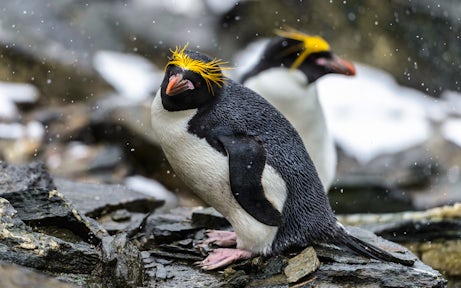
The gentoo penguin is the most common penguin to see during an expedition to the Antarctic Peninsula, despite surprisingly being one of the least numerous penguins in Antarctica overall. A further 100,000 are found in South Georgia and 70,000 in the Falkland Islands. Swoop staff have spotted the odd gentoo wandering through the ruins of the whaling station at Grytviken!
The gentoo is easily identifiable by the white patch above its eye, which wraps around like a pair of large white headphones or a headband. They have a distinctive bright orange beak and feet. At 24 inches (61cm tall) they are taller than adelies and chinstraps, and adults generally weigh around 13lb (6kg). They tend to fish within 2.5 miles of their nests but can dive up to 495 ft (225m).

Gentoo penguin in the tussac grass at Godthul
Hard to miss – being a dominant force on many beaches – the island's seal population is truly staggering.
There are well over 2 million southern fur seals, with 95% of the world's population converging on South Georgia each summer. This is a wildlife success story as avaricious sealers all but wiped out the fur seal population in the 18th and 19th centuries. After legislation was put into place to protect them, the population made a strong recovery.
Found in such thick densities in December at the height of the breeding season, going ashore can be a real challenge and at times it simply isn’t practical to try to do so. Despite their doe-eyed looks, caution when walking amongst fur seals is strongly advised as they can be aggressive - please maintain a safe distance at all times.
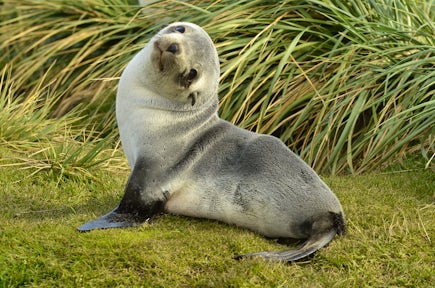
Fur seal pup, South Georgia
Elephant seals on the beaches of South Georgia
On top of the fur seals, half of the world's population of southern elephant seals (more than 400,000 individual animals) also come to South Georgia to breed.
Their curious name comes from their vast size and the large proboscis belonging to the massive adult males. Males elephant seals can be over 20 feet/ 6m long and weigh up to 8,800 pounds (4,000kg), dwarfing the females. Visitors early in the season might catch the huge beachmaster males violently defending their harem.
At any time in the season, it’s great fun to watch these cantankerous seals interact with each other, as well as passing penguins. Huddling for social thermoregulation, you often spot these huge animals clambering on top of each other, accompanied by a cacophony of indignant barks from those being trampled on. They are also noticeably gaseous (from both ends!), which contributes to the overall din!
Wandering albatross nesting on Prion Island
A black-browed albatross
A haven for birdlife, with an estimated population of well over 65 million birds, South Georgia is the world’s most important seabird breeding site.
There are over 30 known bird species on the island, including half the world’s population of Antarctic prions and 250,000 albatrosses of different species. One-fifth of the world’s wandering albatrosses – the bird with the largest wingspan of all at over 3 metres – also calls this small island home.
For bird enthusiasts, Prion Island hosts nesting wandering albatross sites, which are accessible via a series of boardwalks that are sometimes zealously guarded by fur seals. Please note that access to the island is strictly controlled; it's closed to all visitors between 20th November - 7th January (inclusive).
Birders must also look out for the two endemic species found here. The South Georgia pipit is the only subantarctic songbird. The second is the unassuming-looking South Georgia pintail, a carnivorous duck, which is known to feed on dead seals!
Enjoying whale sightings around South Georgia is tempered by the still visible scars of the whaling industry, which once dominated this island. This is most notable at Grytiviken, where huge tanks still stand that once stored the blubber of these gentle giants. Over 175,000 whales were processed in South Georgia alone and there is some haunting footage at the museum there.
Happily, the cetacean population does seem to be slowly recovering and one recent scientific study spotted a number of blue whales, who were previously thought to have been exploited beyond the point of recovery.

The Norwegian Church amid the ruins of Grytviken whaling station
Humpbacks start to arrive from their tropical breeding grounds in November and are frequently sighted, particularly between the island and Antarctica, so keep your eyes peeled during your sea crossings. They are easily identified by their long white pectoral fins and the distinctive hump by their dorsal fin.

Spot humpback whales
Fin whales are also in residence, the second-largest of the great whales, particularly off the island’s southern coast. Known as the greyhounds of the sea, they are incredibly fast, easily outstripping your ship.
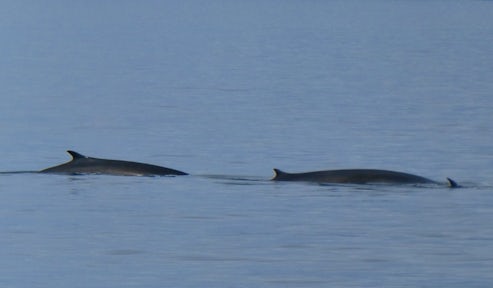
Fin whales
Though rare for visitors to see, if you are lucky enough, blue whales are easy to spot by their sheer bulk and their small curved dorsal fin located well back on the body. The dorsal fin and pigmentation pattern on the side of blue whales provide a fingerprint for identification.

Blue whale
If you manage to get a good photo of a whale, please submit it online to https://happywhale.com – a citizen science project that aims to track these cetaceans around the globe.
On arrival at South Georgia, you will be given a mandatory briefing on biosecurity. The objective is to prevent the introduction of any non-native species. As with Antarctica, you will need to check your boots and all your clothing (looking particularly carefully at any velcro or mesh areas) for any trapped seeds or organic material.
As with Antarctica, the habitats of South Georgia are extremely fragile and at risk from invasive species. In 2018 the island was finally declared rodent free, the result of a painstaking 7-year programme to relieve the pressure on ground-nesting birds. You can read more about this programme on the Government of South Georgia's website.
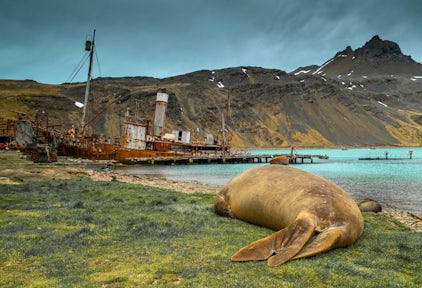
An abandoned whaling ship at Grytviken
South Georgia often surprises visitors by being just as wild, if not more so, as Antarctica. Your expedition leader will have a number of backup plans, as Plan A can often be disrupted due to challenges such as high swells or aggressive fur seals preventing safe beach landings. It is very important to “go with the flow” during your time exploring South Georgia.

As Antarctica's popularity continues to grow, the need to protect its ecosystems is ever-important. Simple biosecurity procedures ensure responsible visits.
Discover More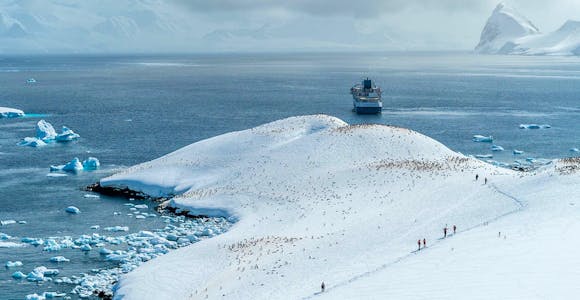
Make sure you are fully prepared for your time in Antarctica. Discover everything you need to know from fitness to seasickness.
Discover More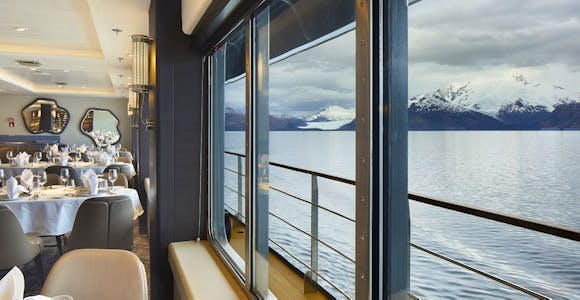
This guide will show you what to expect from the practical side of expedition cruising and what day-to-day life will look like on board your ship.
Discover More